Fighting the gum leaf skeletoniser from the inside out
Toni Withers, Belinda Gresham, Lisa Berndt and Michelle Harnett, New Zealand Tree Grower February 2015.
A tiny wasp, Cotesia urabae, is becoming established in a number of places in New Zealand as a biocontrol agent to control the gum leaf skeletoniser, Uraba lugens. The gum leaf skeletoniser is an Australian moth, named for the eating habits of its hairy caterpillar. When small, the caterpillars nibble away the edible portions of eucalypt leaves leaving a skeletal framework.
The gum leaf skeletoniser was first seen in the Bay of Plenty in 1995 and controlled with pesticide. However, when it was discovered in Auckland in 2001 the infestation was so widespread that it could not be contained. Since then, the gum leaf skeletoniser has been found at other North Island sites and in Nelson in the South Island. In Auckland, large shade trees have been infected. And apart from attacking eucalypts, its presence is a public health problem. The caterpillars have tiny hairs which are like a hollow needle and cause serious skin irritations on contact.
The caterpillars are well-known for defoliating eucalypts throughout Australia and there are sporadic outbreaks of the pest. A severe outbreak in Western Australia lasted from 1982 to 1988, eventually affecting 300,000 hectares of jarrah Eucalyptus marginata. Why outbreaks occur is unknown, but stressful climate problems, such as floods and droughts, have been implicated, as has the ability of the gum leaf skeletoniser to produce two generations a year.
The gum leaf skeletoniser has the potential to become a serious pest in New Zealand, especially with extreme climate problems becoming more common, and the insect producing two generations a year in Auckland. Young trees can be killed by a severe infestation. While defoliation will not kill a mature tree, its growth will slow. If an Australian-type outbreak occurred in New Zealand, pulpwood rotation length would be extended and trees in public parks and gardens would need to be removed and replaced. The potential cost of the damage to New Zealand forestry and amenity trees is estimated to be between $100 and $140 million.
Caterpillars and natural enemies
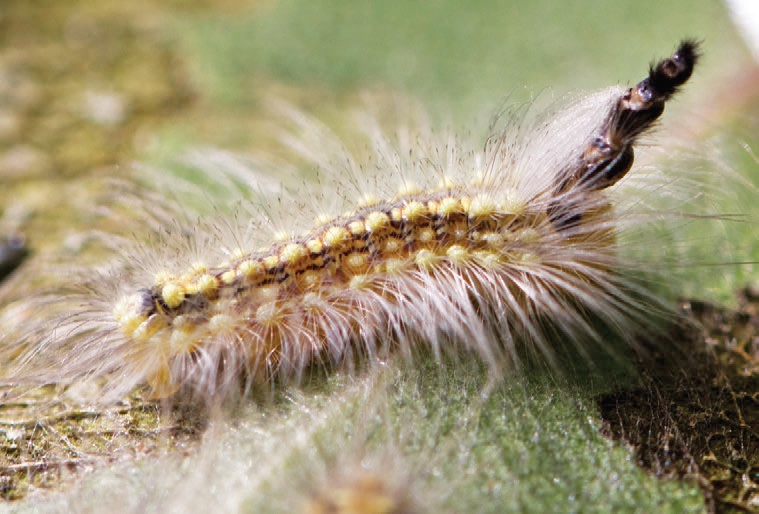
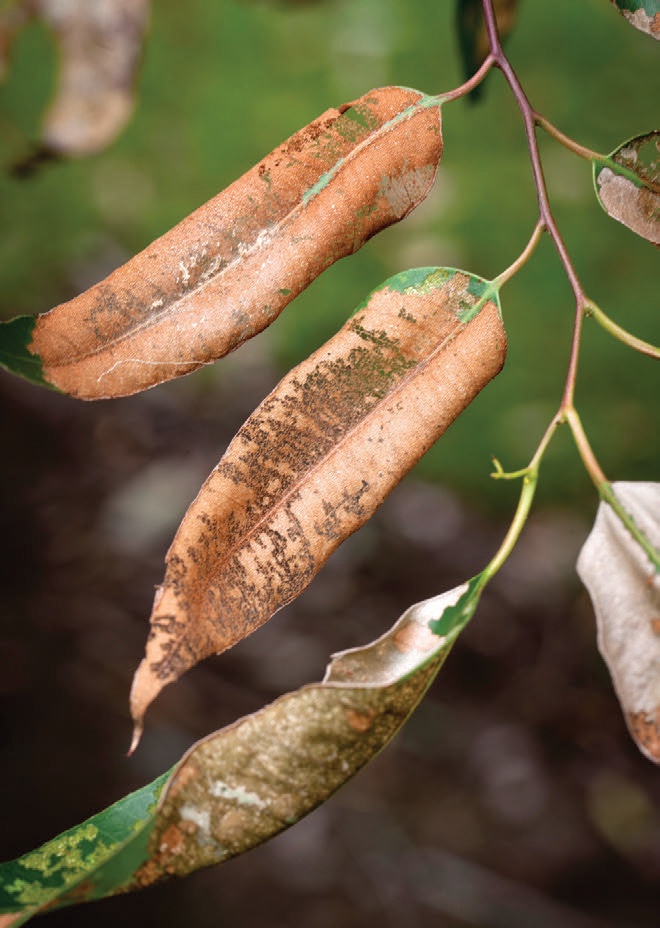
Biocontrol is the deliberate use of natural enemies to reduce a pest population. One of the natural enemies of gum leaf skeletoniser, the three millimetre long parasitoid wasp C. urabae, is a particularly good candidate for biocontrol.
Parasitoid insects lay their eggs in or on the eggs, caterpillars or pupae of other insects. Their larvae hatch and feed off their hosts and eat them alive. Parasitoid wasps are usually specialised and prey on just one insect host. This makes them ideal biocontrol agents as they do little or no damage to plants and other insects.
C. urabae controls gum leaf skeletoniser by laying its eggs inside the caterpillars. Just one egg develops into a larva that feeds within the caterpillar and when it is ready to pupate it eats its way out of the caterpillar, killing it. The wasp is host specific and unlikely to pose a threat to native New Zealand species, and as it comes from Tasmania, it is likely to thrive in New Zealand’s climate.
Work to assess the parasitoid’s potential started at Scion in 2007 and permission to release C. urabae was gained in 2010. The work was funded by a number of sources including regional councils, South Woods Export Ltd, the NZFFA, the Forest Biosecurity Research Council, the Forest Industry Development Agenda, the Sustainable Farming Fund and the government.
Release and establishment
Releasing a biocontrol agent is not simply a matter of letting some insects go. Factors to consider include the time of year, synchronising the life cycle of the pest and predator and how to ensure the biocontrol agent survives, finds and attacks the target species, and eventually thrives.
Researchers first released C. urabae at several sites in Auckland in 2011. Mated adult wasps were released in sleeve cages containing 30 to 60 U. lugens caterpillars. The sleeve cages were attached to infected trees for 24 hours to maximise the chance of the wasps attacking the host larvae then the cages were removed to encourage the wasps to disperse.
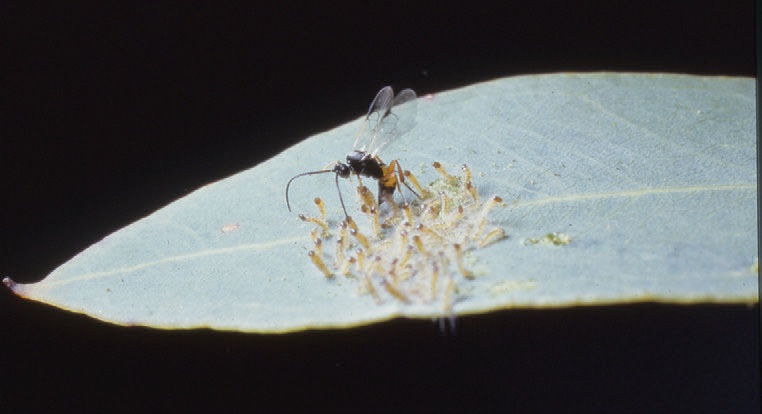
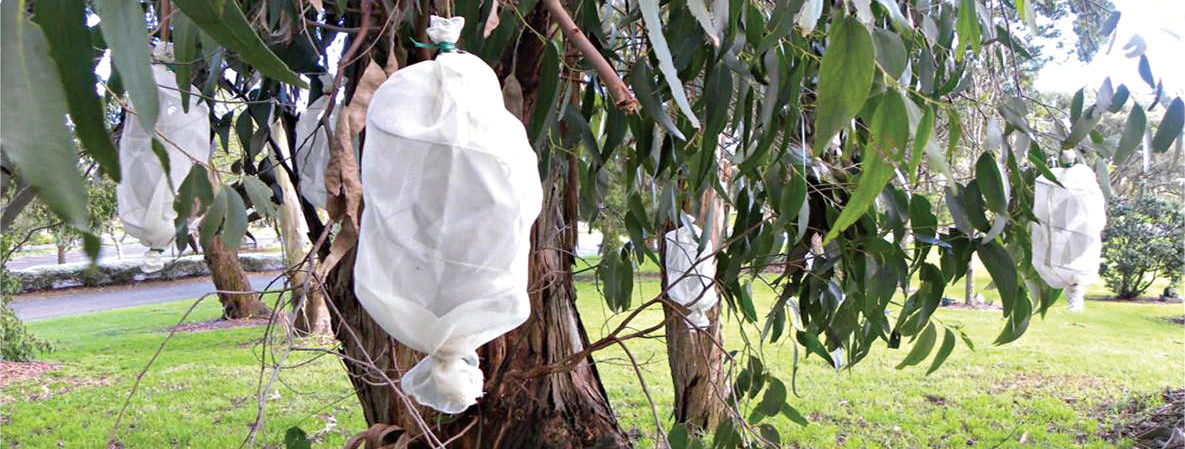
Mated wasps work better
The wasps were mated before release because unmated females only produce male offspring and prefer to attack their prey rather than mating. This behaviour can result in fewer female offspring being produced in the field which can cause establishment attempts to fail.
More recently, Scion entomologists have tested a new release method. Mated parasitoids are allowed to attack masses of caterpillars in the laboratory, then leaves covered in caterpillars infested with parasitoid larvae are stapled on to infested eucalypts. Some of the benefits of the new method include improved ease of handling and greater flexibility around the timing of parasitoid release. It is also more cost effective as less time and fewer resources are needed in the lab and the field.
The new method was used in Whangarei in 2012 to successfully establish a population of C. urabae. It has also been used in Nelson and Napier although it is too early to say whether or not the parasitoid has become established in either of those two locations. The presence of C. urabae at the release sites is continuing to be monitored.
Hardwood eucalypts
Gum leaf skeletoniser has not been reported in other locations but new eucalypt pests are naturally of concern to foresters. For those involved in the promotion and growing of durable eucalypt species, the suggestion that a hungry caterpillar might threaten their trees is worrying.
Interest in planting and growing eucalypts as a sustainable source of hardwood is increasing as the wood is seen as a replacement for copper, chrome arsenic treated radiata. CCA-treated wood is banned for many uses in the USA and parts of Europe. Selected Australasian durability class one and two eucalypt hardwoods are ideal for replacing treated wood anywhere timber comes into contact with the soil, such as fence posts, power poles and even outdoor furniture. The possibility of using eucalypt post in vineyards is an area that has received particular attention. Broken treated posts from vineyards create thousands of cubic metres of waste every year that must be disposed of in secure landfill.
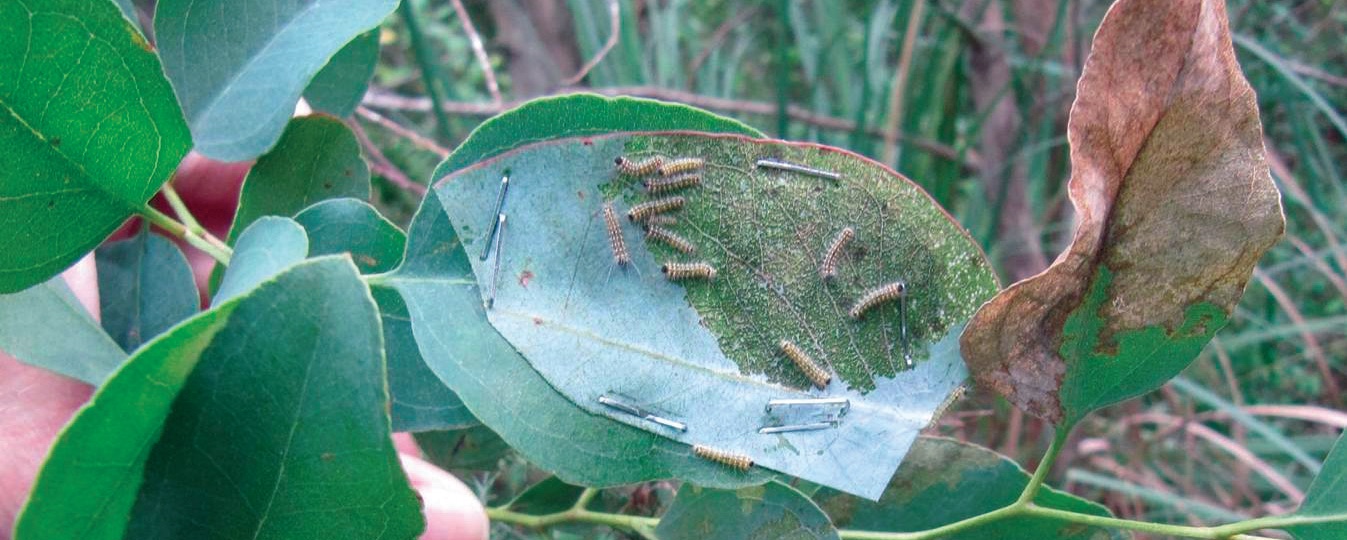
Resistance is not equal
Some eucalypts are more resistant to pests than others and the species recommended for hardwood planting tend to be less susceptible to insect pest problems than the species grown for fibre. In particular, stringybarks such as E. globoidea seem less appealing to pests.
Less is known about the attractiveness of E. bosistoana, a hardwood species growing in popularity, although attacks by the eucalyptus tortoise beetle Paropsis charybdis in Marlborough and the black butt leafminer Acrocercops laciniella in Northland have been reported. It is not known whether this species may also be on the menu for one of the new unwanted insect incursions, the bronze bug Thaumastocorus peregrinus which is currently turning the attractive urban tree E. nicholii a red-colour in Auckland. This bronzing is a result of the tiny flea-like pest sucking out the green contents of leaf cells.
What is next for pests?
The presence of gum leaf skeletoniser, eucalyptus tortoise beetle, black butt leaf miner, bronze bug and other insects and diseases which have arrived at various times from Australia is a sobering reminder of the need for stringent biosecurity measures. There is also the need for effective ways to detect, contain and combat new arrivals. As a result, the search for new biocontrol agents never stops.
The next pest in the sights of Scion biocontrol scientists is the eucalyptus tortoise beetle, first reported in 1916. Current biocontrol agents have failed to sufficiently reduce the population of the pest, but the beetle in its native range of Australia is also preyed on by its own specialist parasitoid wasp Eadya paropsidis. Scion has been granted permission from the Environmental Protection Authority to import E. paropsidis into its high security containment facility in Rotorua and to evaluate its potential to control the tortoise beetle without harming any other beetles, thanks to another Sustainable Farming Fund grant and industry support.
Promising future
The information and experience gained from the C. urabae biocontrol project will be used to refine research methods and to increase the likelihood of success. Skills the scientists learn from the work will also be able to be used to streamline future research on and introductions of effective biocontrol agents for other pests.
What about the gum leaf skeletoniser? Of the nearly 500 caterpillars collected last summer in Auckland, 40 per cent were found to contain the C. urabae parasitoid, showing the wasps are well established there. This is a promising result for the suppression of the gum leaf skeletoniser and one more step towards ensuring that all New Zealand’s valued forestry and amenity trees stay healthy in the years to come. For more information contact Toni Withers email toni.withers@scioresearch. com.
Belinda Gresham is an entomologist at Scion, Lisa Berndt is aTeam Leader at Scion and Michelle Harnett is a Science Communicator at Scion.

 Farm Forestry New Zealand
Farm Forestry New Zealand